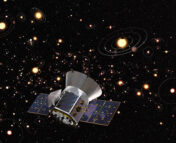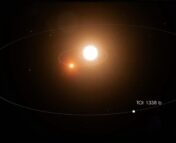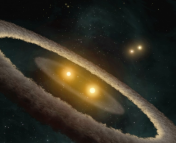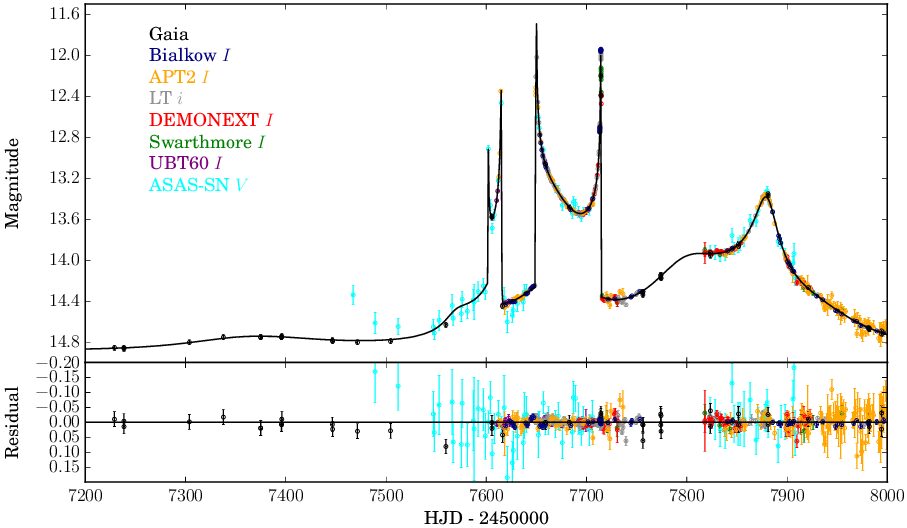Title: A Possible Alignment Between the Orbits of Planetary Systems and their Visual Binary Companions
Authors: Sam Christian, Andrew Vanderburg, Juliette Becker, et al.
First Authors’ Institution: Department of Physics and Kavli Institute for Astrophysics and Space Research, Massachusetts Institute of Technology, Cambridge, MA, USA
Status: Published on ArXiv, 31 Jan 2022. Accepted for publication in AJ
Most stars in the galaxy have binary companions, and most stars host planets. We know this at least since the very successful Kepler mission, which has found an incredible number of exoplanets since its launch in 2009. This naturally implies that many stars in binary systems will host planets themselves, which raises interesting questions about how the planets form around the stars and interact with them. As such, today’s authors are investigating to what extent the orbits of stellar binaries are (mis)aligned with planets orbiting one of the stars.
How can stellar binary systems form?
There are two main ways of forming a binary star system. Either, both stars form somewhat independently from each other in a giant molecular cloud core, and get later captured in a binary orbit. This would leave the direction they spin independent from each other, since the initial stellar spin axis is determined by the random turbulent motions in the molecular cloud. Or, the binary stars form from the same disk via turbulent fragmentation. This would leave both stars spinning in exactly the same direction, and therefore aligned with each other.
Now, since planets form in protoplanetary disks, which are aligned with the central star’s initial spin direction, the inclination of an exoplanet orbit should match the star’s initial spin direction (at least discounting other dynamical effects). Thus, understanding the degree of (mis)alignment between planetary orbits and binary orbits allows us to put useful constraints on binary formation processes, how they vary with stellar properties, and the importance of dynamical interactions in binary systems.
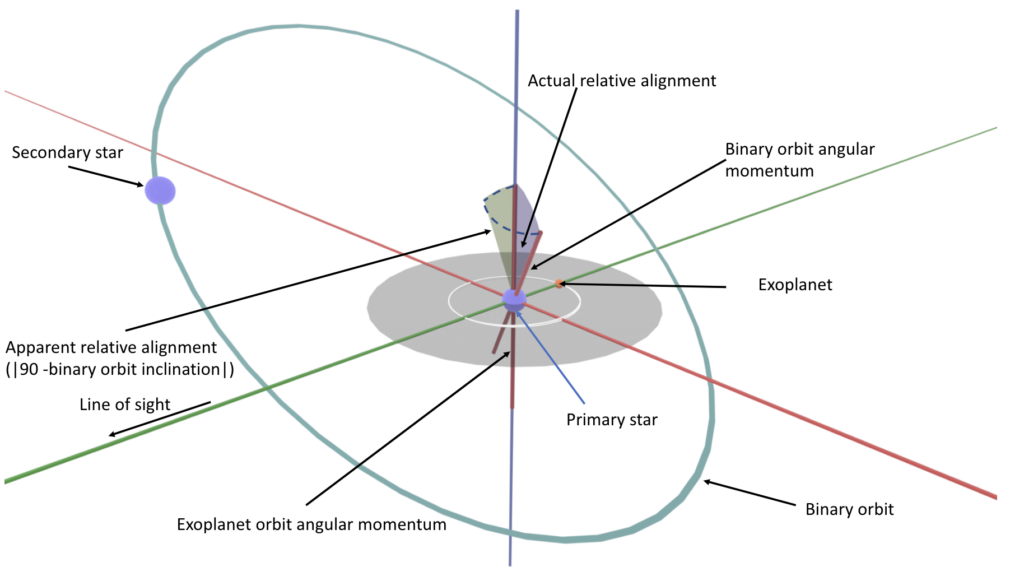
Observations with TESS and Gaia
Measuring the relative inclination between binary orbit and planetary orbit is a challenging task and has only been made possible through recent advances in observational Astronomy. Today’s authors make use of two main space telescopes, the Transiting Exoplanet Survey Satellite (TESS), operated by NASA, and Gaia, operated by ESA. TESS uses the transit method to identify a multitude of exoplanet candidates, while Gaia can make precise astrometric measurements (movement and position of stars) of nearby binary systems. The authors of today’s paper cross-matched the two databases and arrived at a curated sample of 67 binary systems that each contained a transiting exoplanet. In order for a planet to be detectable with the transit method, the planet must pass in front of the host star relative to the TESS spacecraft. This means that all planets in the sample will have an inclination of 90 degrees with their host star. The orbital setup of such a system is shown in Fig. 1.
To avoid selection effects, the authors compared their population with a control sample of binary systems which do not display a transit signal, so they either do not host a planet, or contain a planet with an unknown inclination. The stellar properties of the control sample were chosen such that they roughly match the population statistics of the 67 systems with planets.
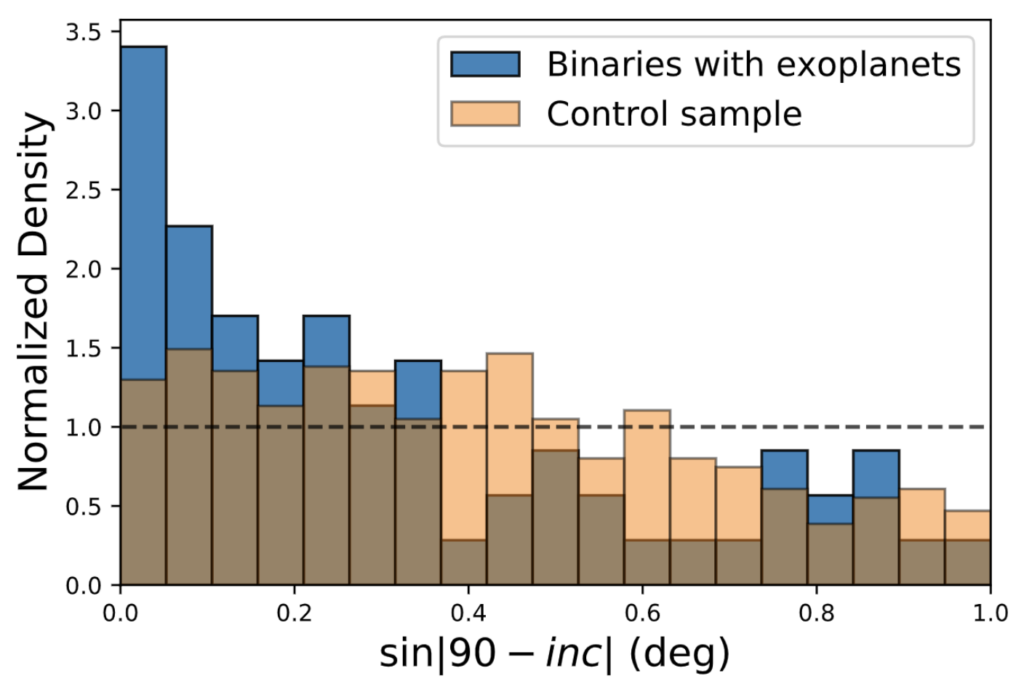
Planets tend to align with their binary companions
The authors calculate the relative inclination given by the difference of planetary inclination (which is always 90 degrees) and the stellar inclination of the binary measured by Gaia. Fig. 2 shows a histogram comparing the relative inclinations of the two populations of systems. If the binary orbits were randomly distributed relatively to the exoplanet orbit (as would be the case if for example the binaries formed independently in a giant molecular cloud) then, all bins in the histogram would be of equal height. However, there are significantly more binaries that are aligned with the exoplanet (relative inclination of zero (left side of the plot)) compared to misaligned planets (see blue bins in Fig. 2). This indicates that either planets indeed formed in the same primordial disk plane as both stars, or that dynamical effects throughout the evolution have forced the planet into an aligned configuration with the binary star system.
Interestingly, the control sample also depicts some small favoring of edge-on systems over face-on systems, even when the geometric bias is subtracted. This results in more orange bins to the left side of Fig. 2 compared to the right side. The authors contribute this to selection biases, and state that the alignment of the binaries that host planets is nevertheless significant.
Why are the systems aligned?
Intuitively, one would think that the wider the binary separation, the less likely it becomes that they formed from the same disk and thus depict alignment. Indeed, the authors find that alignment decreases with binary separation. Interestingly, there is still significant alignment between binary and planetary companion far beyond the size of the primordial disk, rendering the possibility that such a system originally formed aligned quite unlikely. The authors argue that the most likely mechanism to explain this surprising alignment of wide binaries is the protoplanetary disk around the primary star being torqued and warped by the influence of the nearby binary. However, to conclusively understand the origin of wide binary alignment, the authors advocate for increasing their sample size. This would not only shed more light on the binary formation processes but also allow for statistical statements how alignment correlates with stellar, and planetary properties.
Astrobite edited by Mark Popinchalk
Featured image credit: NASA

